Customer transformation is about shifting from firefighting problems to proactively shaping customer experiences to grow satisfaction and trust.
For SMBs, that means stronger retention and steadier revenue, even with limited resources.
This article gives you a five‑step framework for implementing customer transformation. You’ll learn how to map your customer journey, set up simple automations, personalize outreach and track the results.
Key takeaways
Mapping the customer journey, workflow automation and personalization are simple ways for SMBs to get started with customer transformation.
Clean, centralized customer data is the foundation for effective transformation and a better digital customer experience.
Measuring retention, engagement and response times helps SMBs track the impact of their transformation and identify areas for improvement.
For most SMBS, a good CRM is enough to put customer transformation into practice – try Pipedrive free for 14 days.
Customer transformation meaning: The process of moving from reactive customer service to proactive, data-driven customer experiences.
Instead of waiting for problems, you anticipate customer needs. Rather than treating everyone the same, you personalize interactions based on their history and preferences.
Example: Say a SaaS company loses many customers at subscription renewal. A reactive approach is to contact customers after the fact to find out why they canceled – or use initiatives like discounts to lure them back.
With a transformed approach, the sales team uses CRM insights to flag accounts with low usage and reach out weeks before renewal. Instead of losing revenue, they open conversations that lead to upsells and long-term contracts.
While most transformation advice assumes unlimited resources and dedicated teams, customer transformation isn’t just for enterprise businesses. Here’s why it matters for SMBs:
Building a sustainable competitive advantage. While larger companies can outspend competitors, SMBs are better able to adapt quickly and deliver more personal customer experiences. Customer transformation turns that SMB agility into an edge.
Retaining more customers. Transformation strengthens customer loyalty, which is cheaper and more effective than always relying on customer acquisition. Retention ensures sustainability for SMBs with limited sales and marketing budgets.
Doing more with the same team. Hiring is costly and slow. Transformation helps SMBs serve more customers and grow revenue without adding new roles.
SMBs need practical approaches that work with limited budgets. That’s why customer transformation for SMBs focuses on improving the use of existing tools rather than introducing new technology.
A strategic, step-by-step approach helps serve your SMB’s customer base while strengthening your market position.
The 5-step customer experience transformation framework for SMBs
Customer transformation doesn’t have to mean a complete overhaul.
Pipedrive’s five-step framework breaks it into simple steps that your SMB can gradually roll out to drive results without disrupting day-to-day business.
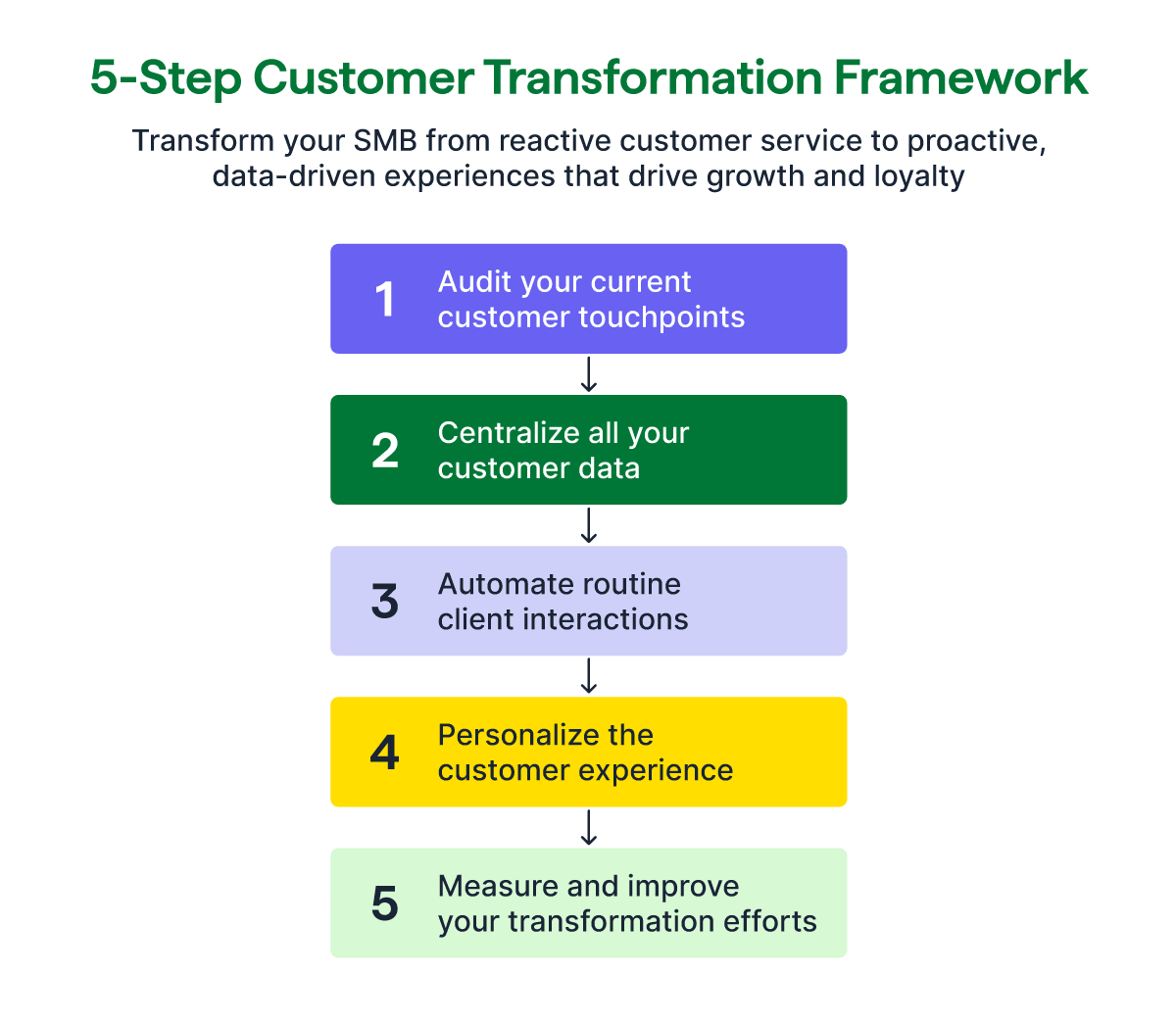
Learn how and why you should achieve each transformational step below.
1. Audit your current customer touchpoints to spot transformation opportunities
Start by defining how customers interact with your business now.
Create a simple customer journey map by tracking how people move from first contact to purchase.
If you use a customer relationship management (CRM) platform like Pipedrive, look at sales deals you made and the communication history to understand the timeline of customer relationships.
Market research like this helps you understand your target audience better. Look for these specific issues:
Communication gaps. Where do customers typically go silent or express frustration?
Response time delays. How long does your team take to respond to different types of inquiries?
Information silos. Do customer details live scattered across different team members’ notes?
Inconsistent experiences. Do different team members handle similar situations differently?
Document findings in a shared spreadsheet to easily spot patterns or pain points.
The goal isn’t perfection. A solid overview of your current baseline lets you pinpoint areas to optimize the customer experience.
Example: A small marketing agency audits its touchpoints and finds that new prospects often wait more than 48 hours for a response to discovery call requests. Documenting this in a shared spreadsheet highlights a high-priority area for improvement.
2. Centralize and organize your customer data to see the full picture
Consolidate all customer information into unified records so your team has a single source of truth.
For instance, store records in your CRM or a shared Google Drive.
While poor data quality sabotages transformation efforts before they start, organized data allows you to understand specific customer expectations and personalize outreach.
Here’s how to compile easily accessible customer data:
Decide what data matters. Focus on information that helps effective marketing decision-making, such as customer preferences, demographic and psychographic segments or buying history.
Standardize how you capture data. Create clear rules for entering information so everyone contributes consistently (e.g., always include next steps or tag by company size).
Segment and prioritize customers. Identify high-value, at-risk or expansion-opportunity accounts so your team knows where to focus.
Pipedrive’s duplicate detection feature merges scattered customer records and eliminates confusion.
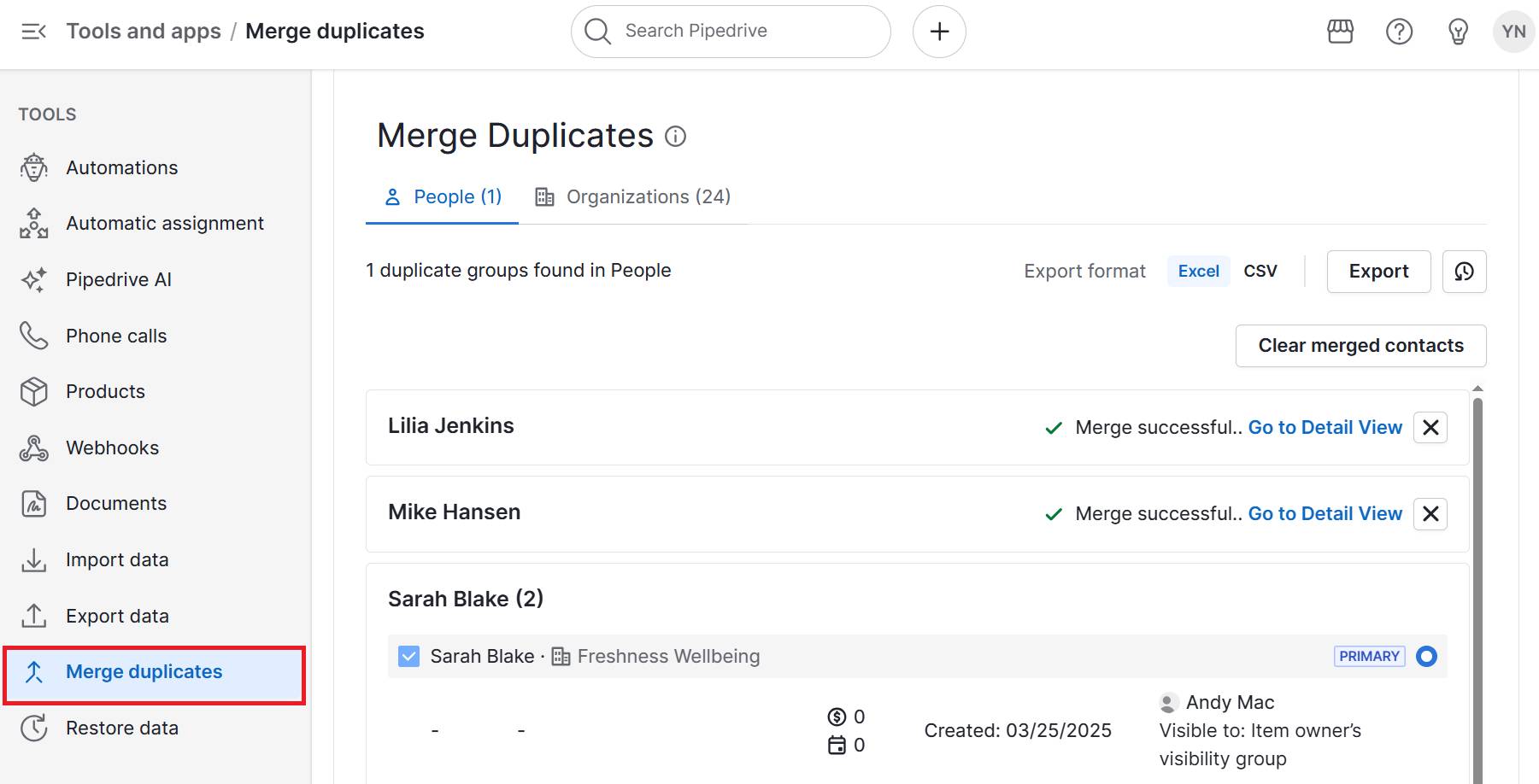
Use the custom label function for quick market segmentation. Tags like “high-value”, “at-risk” or “expansion-opportunity” help your team customize marketing tactics.
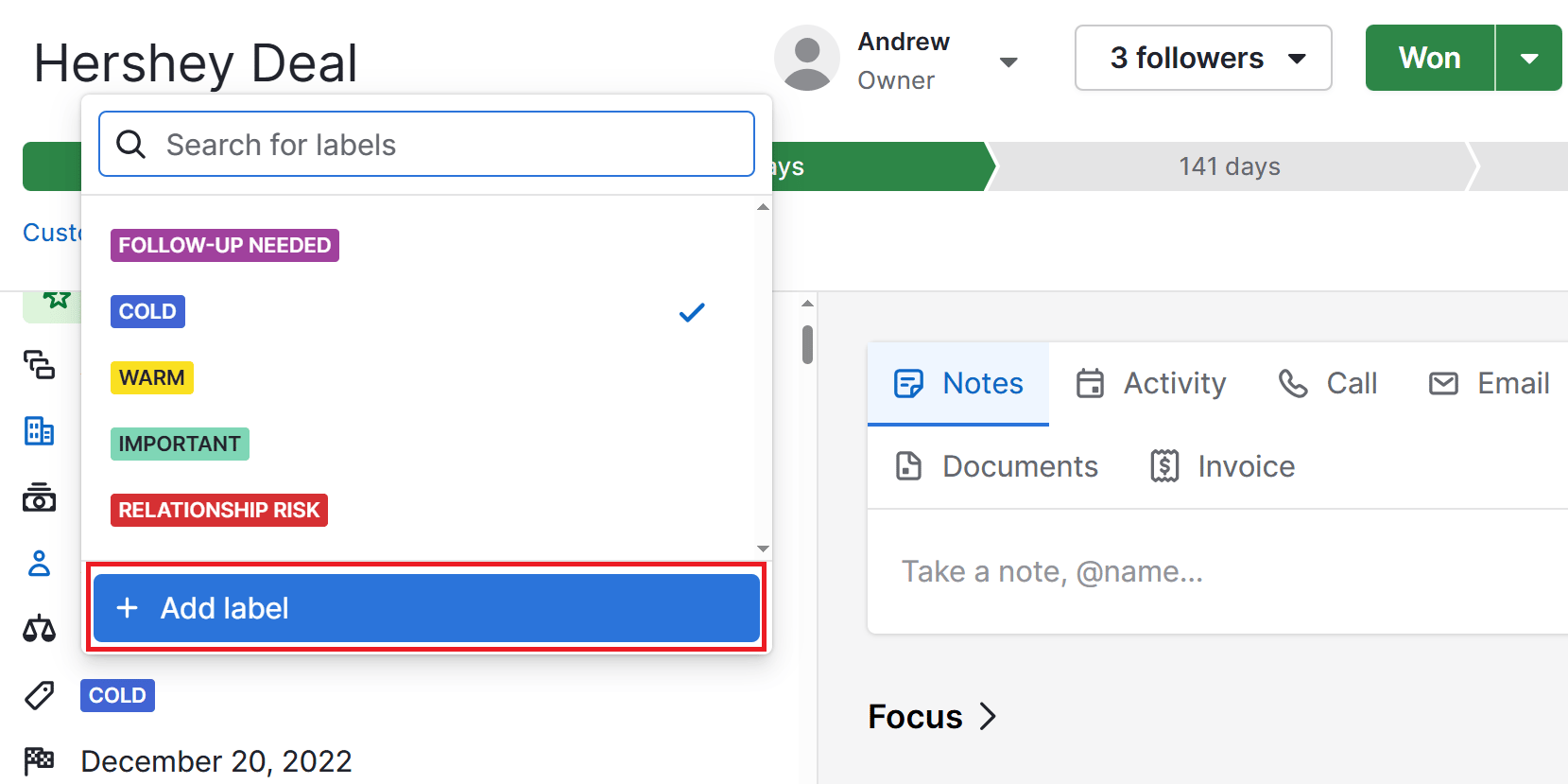
The more thorough your data is, the more effective your customer transformation efforts will be.
Example: The same marketing agency centralizes all prospect data in its CRM and finds several leads duplicated across records. This error causes confusion about whether discovery calls have been scheduled. The team merges duplicates and tags prospects by priority to ensure timely follow-ups.
3. Automate routine customer interactions to free up your team
Workflow automation handles repetitive tasks so your team can focus on high-value customer conversations.
While more for customers is great, doing it consistently is what drives customer transformation.
For small teams in particular, automating tasks helps them stay customer-centric and respond quickly to customer needs, even when they’re short on time.
Use the customer segments you created in the last step to decide which tasks to automate first. Focus your marketing automation strategy on the groups where it will have the biggest impact.
Here are some examples:
Welcome email series – new customer onboarding that introduces your team, sets expectations and provides useful resources
Follow-up reminders – automatic tasks to make contact when deals stall or to check in with new customers
Renewal alerts – notifications before contract renewals so you can be proactive and confirm pricing with customers
Milestone celebrations – automated messages acknowledging customer anniversaries or achievements
Pipedrive has a range of automation templates to help you get up and running fast.
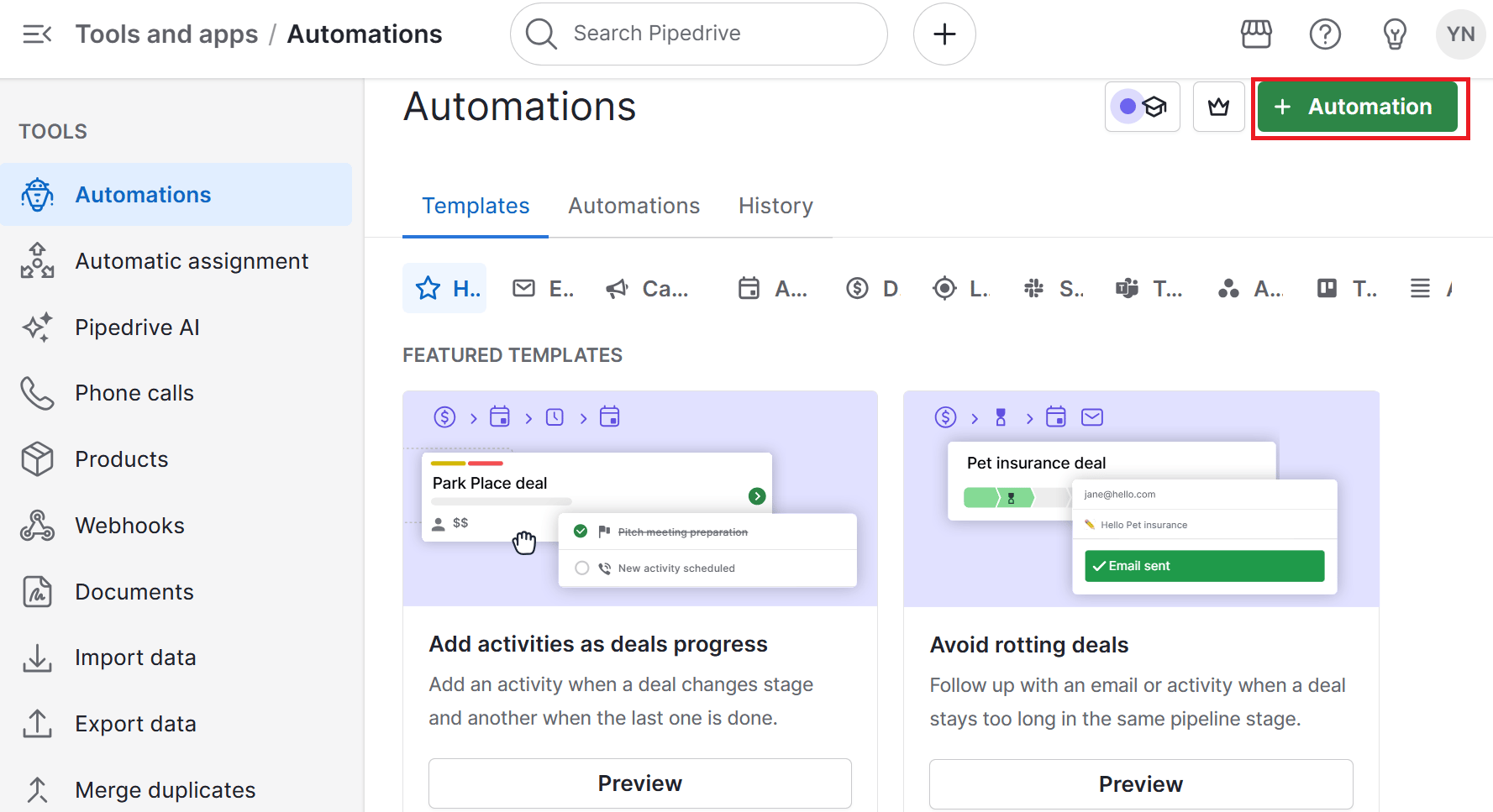
Remember that automation should enhance human connection, not replace it. Prioritize personal outreach for difficult conversations and relationship building to maintain customer satisfaction.
Example: The agency sets up an automated email sequence for prospects who request a discovery call. This activity ensures that every lead receives a timely response.
Automation creates consistency, while personalization creates connection. Your next step is to make every interaction feel tailored to the customer.
Pipedrive in action: Real estate franchising network J’achète en Espagne used Pipedrive to automate personalized emails at different sales pipeline stages.
In addition to saving hours of admin time, automation contributed to a 20% increase in revenue. As founder Thomas Rouer explains:
“We have filters like prospects, customers who bought or did not buy and region. If you have a template that you just need to push, it saves so much time. My team can focus on selling.”
4. Personalize customer experiences to improve engagement
Personalization helps you build stronger relationships by showing customers you appreciate them and listen to their needs.
Transform generic interactions into personalized experiences using these methods:
Reference past interactions and purchase history in emails or calls. “Hi [First Name], I noticed you bought [Product A] last month. Here’s a tip on getting the most from it”.
Segment your email list by lifecycle stage or customer behavior to deliver targeted messaging. Send high-value customers an exclusive update, while new customers get onboarding tips.
Use insights from CRM data to suggest relevant new products or resources. If a customer frequently purchases [Product B], suggest a complementary add-on before they ask.
Artificial intelligence (specifically generative AI) makes it easier than ever to personalize messages.
Pipedrive’s AI email writer summarizes customer conversations in just a few seconds. Once you’re up to speed, prompt the AI to include details specific to the customer.
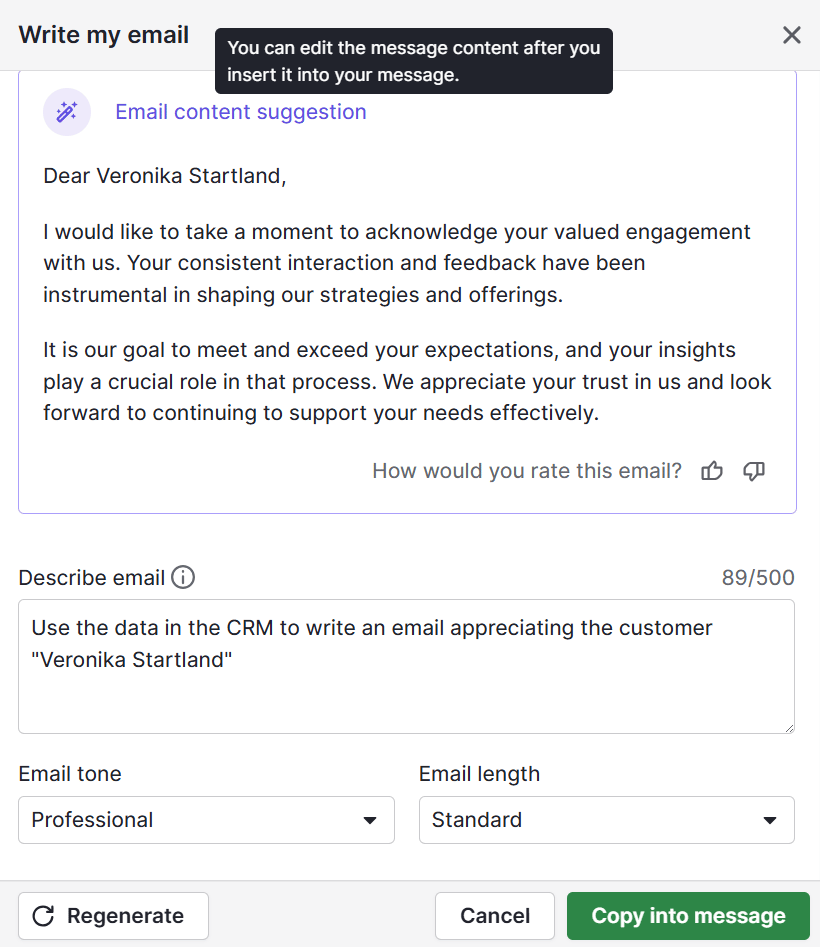
Lastly, select the tone and length of email you need for an AI-driven email that’s professional, well-written and customer-focused.
Example: A marketing agency prospect ticks that they’re interested in social media management on their discovery call request form. The agency’s sales rep uses the AI email writer to suggest helpful resources, like their LinkedIn guide.
5. Measure the impact of your transformation efforts so you can improve
Remember: you can’t improve what you don’t track.
The right metrics show whether your customer transformation is impacting your business goals and revenue growth.
For SMBs, focus on simple, actionable data points:
Metric | How to measure it |
Customer retention rate | Export your customer list from your CRM and compare the number of active customers at the start and end of a period. Calculate: (active customers at end ÷ active customers at start) × 100 |
Customer response time | Use your CRM system or helpdesk to track timestamps for incoming inquiries and when your team first replied. Average these across all inquiries to get your response time. |
Customer engagement | Check email opens or clicks, content downloads or product usage reports in your CRM or marketing analytics tool. Segment by customer group to spot who is highly engaged or at risk. |
Pipedrive’s revenue forecast report shows the value of your open and expected deals over time. This data shows whether your improved overall customer experience translates to increased profitability.
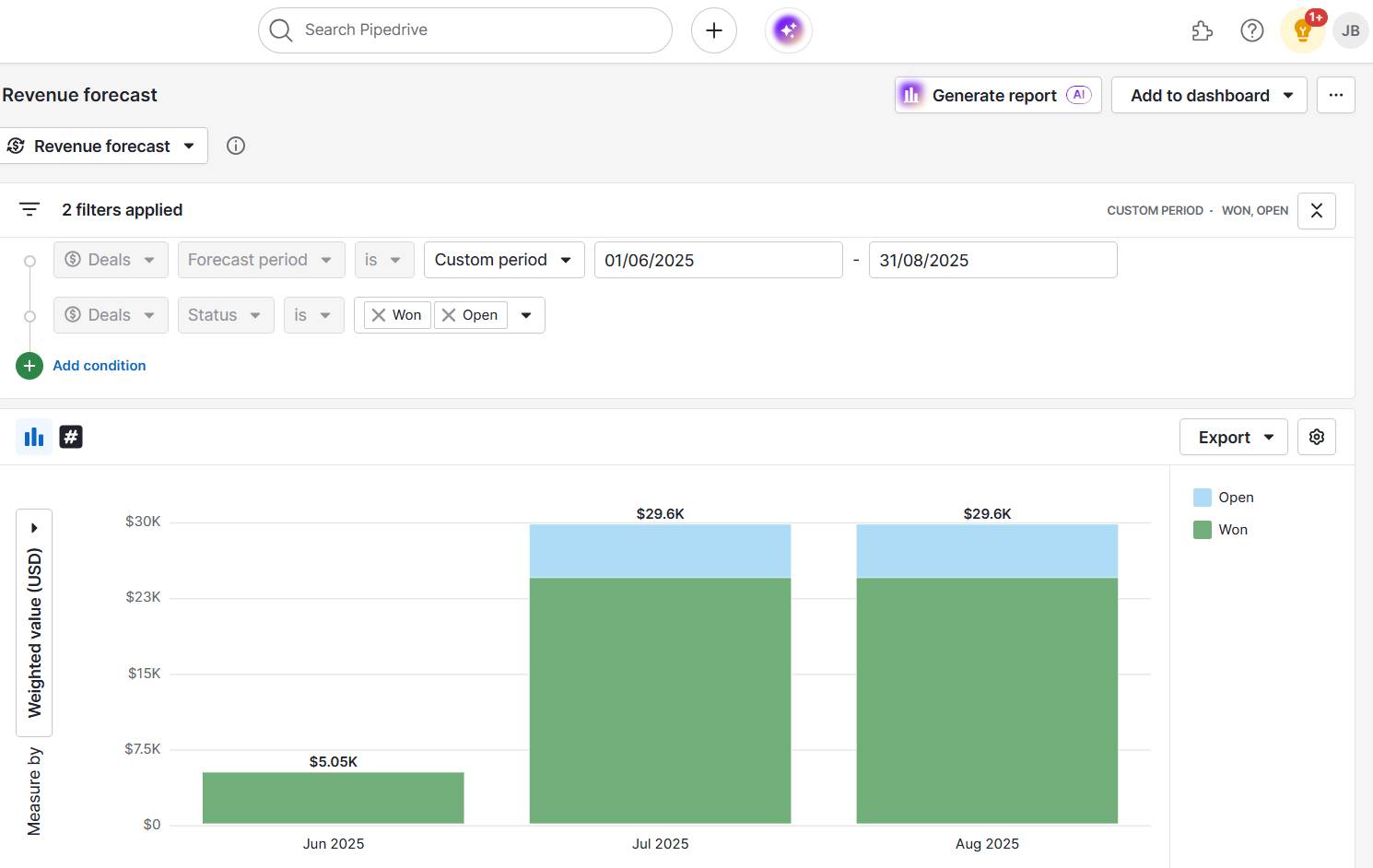
Review these metrics quarterly and adjust your marketing strategy based on what the data reveals. For example:
Customer retention rate is declining. Identify the point in the customer journey where churn occurs. If customers stop using a key feature after week two, send a targeted tutorial or schedule a check-in call at that stage.
Response times are slow. Check which channels or types of inquiries are lagging. If support emails take two days to respond, set automated reminders for the team and assign specific agents to high-priority questions.
Customer engagement is low. Compare engagement across segments. For inactive users, try adding interactive content like product demos or webinars. For active users, test A/B variations of emails to see which content drives more clicks.
Revenue from deals is below forecast. Analyze which customer segments are underperforming. For instance, offer bundle deals to mid-tier accounts with declining renewals. Create upsell campaigns for customers who recently purchased complementary products.
Customer transformation is iterative. Small improvements compound over time into significant competitive advantages.
Example: The marketing agency team notices prospects aren’t engaging with the LinkedIn guide in their email. When it tests a new AI-written email highlighting relevant social media case studies, click-through rates improve.
Following these steps drives steady gains in customer transformation. Additionally, SMBs should monitor their progress closely for anything that might undo it.
Customer transformation mistakes SMBs should avoid
Being aware of mistakes from the start of your SMB’s transformation strategy prevents costly missteps. Here are a few pitfalls to watch for.
Trying to transform everything at once
Transforming everything in one go overwhelms teams and slows down day-to-day work.
Instead, tackle one step at a time. Clean up your customer data first, then move on to automation. Only add personalization after you’ve completed these steps.
Taking transformation slow and steady ensures sustainable growth.
Ignoring data quality in CRM records
Tidying up data isn’t the most exciting task, but avoiding this step has a knock-on effect.
Automated emails with incorrect names damage relationships. Market segmentation based on outdated information lessens the impact of marketing campaigns.
Keeping your data clean gives you the biggest return on investment (ROI) for your efforts. Check your customer records periodically for duplicates or incomplete entries to ensure organization and accuracy.
Not asking for customer feedback
Transformation should improve customer experience, but you won’t know if you’re succeeding without asking customers directly.
Send simple surveys after implementing changes via a website chatbot or email. Here’s a simple example from insurance company Getsafe:

Use the customer feedback to optimize your approach.
Focusing on vanity metrics instead of business impact
Enterprise transformation often emphasizes metrics like “digital engagement score” or “omnichannel optimization”.
Large companies can afford to invest in these because they have complex ecosystems and dedicated teams to act on the insights.
For SMBs, tracking vanity metrics is a distraction. Instead, focus on metrics like retention that actively drive growth.
Set up a simple report on your CRM to track your metrics over time and see whether your actions are making a difference.
Implementing transformation without team training
CRM tools and automation workflows only succeed when your team understands how to use them effectively.
Invest time in training team members on new processes. Explain how individual contributions support broader business goals. Remember that initiatives like workflow automation improve the employee experience too.
When everyone understands the “why” behind the tools, your team is more likely to stick to new processes.
Final thoughts
Customer transformation helps SMBs differentiate themselves and compete with larger businesses, even without a big budget.
Simple automation and personalization can be enough to begin a new era of your customer experience (and operational efficiency for your team).
Your CRM is key to making this transformation real. Pipedrive lets you centralize customer records, automate tasks, track engagement and monitor revenue in one place.







